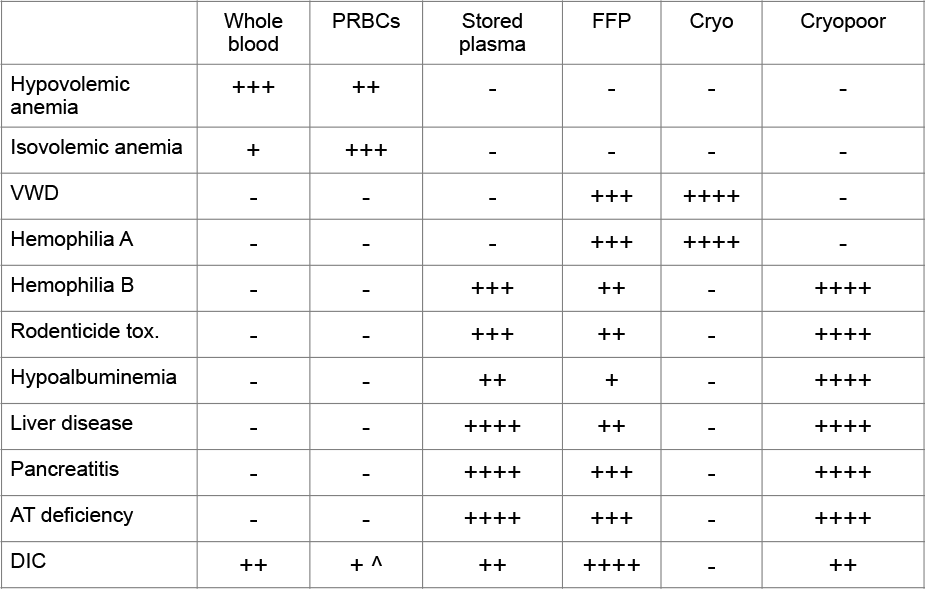Blood Transfusion in Dogs: Don’t Forget The Plasma!

Veterinary transfusion medicine has made great strides in the past decade. Several commercial blood banks for pets are now available; most of them store blood components derived from processing units of whole blood or collected by apheresis (a process in which the patient is connected to an apheresis machine via an intravenous catheter and the machine removes the preselected component while sparing the rest of the blood).
In a typical blood bank situation, a unit of whole fresh blood (WFB) is spun in a refrigerated centrifuge immediately after collection, and packed RBCs (pRBCs) and fresh-frozen plasma (FFP) stored at −20° C to −30° C are prepared. The pRBCs are preserved by adding a nutrient solution and can be stored for up to 5 weeks. After 1 year of storage at −20° C to −30° C, FFP is supposed to lose the labile clotting factors (V and VIII) and is referred to as stored plasma (SP) or frozen plasma (FP); however, we recently demonstrated that 5-year old FP is still hemostatically active and can be used for transfusion in dogs with coagulopathies (clotting disorders).
Some blood banks prepare platelet-rich plasma (PRP) or platelet concentrates by apheresis; a new platelet concentrate is now commercially available in the United states (Bodevet- http://www.bodevet.com). If FFP is allowed to warm up in a refrigerator, a sludge forms in the bottom of the bag when it reaches approximately 4° C to 6° C. That sludge can be separated by a short centrifugation, yielding cryoprecipitate (CRYO), a small volume rich in factor VIII, fibrinogen, and von Willebrand factor (vWF); the supernatant is termed cryopoor plasma.
The transfusion of whole blood or blood components (e.g., pRBCs, PRP, FFP, CRYO, or SP) is indicated in several clinical situations. Whole blood or pRBC transfusion is usually required to restore the oxygen-carrying capacity in patients with anemia. Whole blood may be used if the anemic patient is hypovolemic or if he or she needs clotting factors in addition to RBCs, whereas pRBCs are recommended for normovolemic dogs and cats with anemia (i.e., pure red cell aplasia, anemia of renal disease, hemolysis). Transfusion therapy should be used with caution in animals with immune-mediated hemolytic because a massive transfusion reaction may occur.
Clotting factor deficiencies resulting in hemorrhage can be corrected through the administration of whole fresh blood if considerable blood loss has occurred or, ideally, with FFP, FP, or SP. Cryoprecipitate contains a high concentration of factor VIII and vWF, so it is typically used in dogs with hemophilia A or von Willebrand disease. Cryopoor plasma is a good source of clotting factors (except for fibrinogen, factor VIII, and vWF) and albumin; therefore, it is indicated in patients with common coagulopathies, such as rodenticide toxicity. PRP or platelet concentrates, if available, can be used in dogs and cats with severe thrombocytopenia resulting in spontaneous bleeding. However, the platelet count of the recipient is rarely increased enough to halt bleeding. PRP and platelet transfusions are of little or no benefit in patients with peripheral platelet destruction (e.g., immune-mediated thrombocytopenia) because the platelets are removed from the circulation immediately after the transfusion. Transfusion with whole fresh blood, PRP, or FFP is also indicated for the management of patients with disseminated intravascular coagulation.
Less frequently, plasma is prescribed to correct hypoalbuminemia. However, only rarely can relevant increases in the recipient’s serum albumin concentration be achieved (and this usually happens in small dogs). Colloids or human albumin solutions are more effective for restoring plasma oncotic pressure.

VWD: von Willebrand’s disease; AT: antithrombin; DIC: disseminated intravascular coagulation; PRBCs: packed red blood cell concentrates; FFP: fresh frozen plasma; Cryo: cryoprecipitate; Cryoopor: cryoprecipitate supernatant

